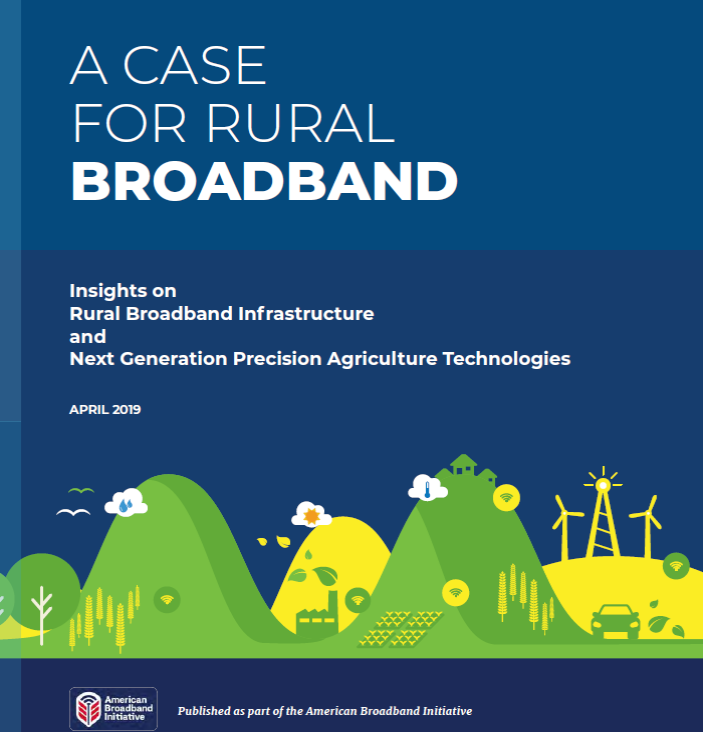Want Next Generation Precision Agriculture? You'll Need Rural Broadband.
Friday, May 3, 2019
Weekly Digest
Want Next Generation Precision Agriculture? You'll Need Rural Broadband.
You’re reading the Benton Foundation’s Weekly Digest, a recap of the biggest (or most overlooked) telecommunications stories of the week. The digest is delivered via e-mail each Friday.
Round-Up for the Week of April 29 - May 3, 2019

On April 30, the U.S. Department of Agriculture (USDA) unveiled A Case for Rural Broadband: Insights on Rural Broadband Infrastructure and Next Generation Precision Agriculture Technologies. This latest chapter in the Trump Administration’s American Broadband Initiative finds that the deployment of broadband networks and adoption of new agricultural technologies could result in approximately $47–$65 billion annually in additional gross benefit for the U.S. economy.
Reliable, High-Speed Broadband and Enhanced Agricultural Production
The USDA has been investing in rural telecommunications infrastructure for decades. But approximately 80 percent of the American households who lack reliable, affordable, high-speed Internet access are in rural areas.
Current USDA telecommunication programs offer more than $700 million per year for loans and grants to defer the costs of the construction, improvement, and acquisition of facilities and equipment for broadband service in eligible rural areas. More funding was added by the Consolidated Appropriations Act of 2018 (HR 1625), the omnibus spending bill for fiscal year 2018, which appropriated $600 million for the USDA's e-Connectivity pilot, which is meant to expedite loans and grants for rural broadband buildout.
According to the new USDA report, until now, the interdependency between broadband and next-generation precision agriculture technologies has not been evaluated. The report “explores this symbiotic relationship and quantifies the potential economic benefit of broadband buildout and the complementary adoption of connected agriculture technologies.”
So what is “next-generation precision agriculture?” The report says it “can be considered an interdisciplinary science leading to breakthroughs and incremental technology advances to improve agricultural productivity, efficiency, and/or sustainability.” Enabled by digital tools and connectivity, next-generation precision agriculture is beginning to be applied across the entire food value chain to the benefit of both the producer and consumer, substantially increasing crop and animal yields, improving distribution, and reducing input costs. And USDA concludes that this technology could “have the potential to generate a ‘killer application’ that leads to a demand for more or quicker expansion of rural broadband infrastructure and services.”
The report notes that the expansion of broadband throughout America’s rural areas would also enable Internet service access for other uses, such as forestry, telemedicine, and distance learning. But bringing broadband to rural areas would benefit more than just the people and companies that live there:
E-connectivity is not simply a rural issue; Internet expansion, economic productivity, and food security contribute to each citizen’s quality of life, regardless of where they live. The benefits of broadband e-connectivity accrue not only to the producers using Next Generation Precision Agriculture technologies, but also to consumers throughout America and the world who value a safe and efficient food supply.
Frustratingly Bad Broadband Data
The lack of reliable broadband data impacted the report. “Cost estimates are excluded because of the lack of clear, accurate, and publicly available data sources on where broadband infrastructure currently exists, and which connected equipment and other devices are presently in use at which farms and ranches.”
So, add the USDA to the large list of agencies, policymakers, and advocates calling for better broadband maps. [The National Telecommunications and Information Administration is working with eight states to update broadband availability data. It is aiming for a September 2019 release.]
Economic Findings
The USDA embarked upon this analysis to estimate the possible economic benefits of expanding rural e-connectivity to farms and ranches, and to explore what’s needed to unlock this potential.
Despite excluding certain cost estimates, the report highlights two major economic findings:
- Deployment of both broadband y and precision agriculture technology on farms and ranches throughout the U.S. could result in $47-$65 billion in national economic benefits every year.
- If broadband infrastructure and digital technologies at scale were available at a level that meets estimated producer demand, the U.S. economy could realize benefits equivalent to nearly 18 percent of total agriculture production. Of that 18 percent, more than one-third is dependent on broadband, equivalent to at least $18 billion in annual economic benefits that only high-speed, reliable Internet can provide.
The report also explicitly draws the analogy between rural electrification and rural broadband. “The rural broadband challenge is not without precedent as rural electrification faced similar dynamics. While the cost of connecting each rural property to the power grid amounted to, on average, nearly a quarter of annual household income, the long-term benefits of rural electrification accumulated for decades.” Improving rural broadband access could “continue to unlock the larger-scale, systems-level change that will significantly transform 21st-century industries.”
Broadband Needed to “Scale Adoption” of Agriculture Technology
Unlocking this potential value, USDA claims, requires America to scale adoption of connected agriculture technologies and expand its rural broadband Internet infrastructure. “[W]ithout reliable, affordable high-speed Internet connectivity at both the farmhouse and in the field, many of these technologies cannot realize their full potential.”
The report details how unreliable broadband service undermines scaling adoption of precision agriculture:
- Some farmers dedicate significant time and effort to find workarounds to insufficient Internet service, which takes time away from managing their businesses and serving their customers.
- Some precision agriculture technologies function with basic Internet connections, so even slow speeds are better than no connections at all. But many require a more reliable and high-speed Internet connection as a minimum requirement.
- Without access to online learning and peer sharing platforms, farmers are less likely to succeed with technology implementation, having wasted money, time, and effort without realizing complete benefits.
Some of the more innovative and risk-tolerant rural telecommunications providers and co-ops are deploying nontraditional, creative methods to help local farmers gain Internet connectivity, highlighting an untapped customer base for larger-scale providers willing to understand and tailor their services to rural communities’ needs.
What’s Next for the USDA
The report says that sustained leadership and coordinated action by public and private players can help address the challenges of getting Internet infrastructure, digital technologies, and on-farm capabilities available at a level that meets estimated producer demand.
This “coordinated action” must focus on six key priorities:
- Tailor deployment of Internet infrastructure to communities.
- Incentivize development of innovative technologies and solutions, both for scaling connectivity and improving agricultural production.
- Create the conditions that allow, encourage, and reward innovation, including identifying the statutory or regulatory obstacles that hinder new, innovative providers.
- Coordinate across public programs to effectively use taxpayer funds and develop new partnerships.
- Build capability to scale adoption and realize value.
- Clarify and emphasize the importance of rural connectivity to all consumers of agriculture commodities.
The report concludes by saying the USDA will be “engaged in multiple facets of infrastructure and technology deployment, including financing rural capital investments.”
USDA indicated that it is committed to answering this call to action with concerted efforts, as well as the implementation of an intradepartmental working group. “We invite our partners to address the challenge as well, so that together, we can deliver lasting prosperity for all Americans.”
Quick Bits
- President Trump, Speaker Pelosi, Senate Minority Leader Schumer agree on goal of crafting $2 trillion infrastructure plan, talk rural broadband (Washington Post)
- NDIA launches new, dedicated website for the Digital Equity Act of 2019 (NDIA)
- FCC approves SpaceX’s plans to fly internet-beaming satellites in a lower orbit (Vox)
- New York Attorney General James Announces Investigation Into Facebook (NY Office of Attorney General)
- FCC Commissioner Rosenworcel Calls for Update on Sale of Real-Time Location Data (FCC)
Weekend Reads (resist tl;dr)
- FCC Claims Revised Draft Broadband Report Still Shows a Narrowing Digital Divide (FCC)
- See Also: Report on Broadband Deployment in Indian Country (FCC)
- See Also: Report on Promoting Internet Access Service for Veterans (FCC)
- Carriers Opt in to USF Funding (FCC)
- See Also: Ajit Pai-proposed upgrade to 25Mbps starts paying off for rural ISPs (ars technica)
- Wireless Carriers Make It Clear: You’re Going to Pay More For 5G (Karl Bode)
- The Network Neutrality Battle Is About Common Carriage Functionality (Barbara Cherry Op-Ed)
ICYMI from Benton
- 57 Rural WISPs File Letter in Support of EBS Filing Windows, Kevin Taglang
- Affordable Broadband for Students Hinges on FCC’s EBS Proceeding, Mitch Koep
- Without the Right Spectrum, Is 5G All That?, Robbie McBeath
Events Calendar for May 2019
May 6 -- Technology, Media & Democracy: Who counts?, NYC Media Lab
May 8 -- Oversight of the FTC: Strengthening Protections for Americans’ Privacy and Data Security, House Consumer Protection Subcommittee hearing
May 8 -- Update on TV White Spaces Technology, SHLB Coalition
May 9 -- May 2019 Open FCC Meeting
May 9 -- Centering Civil Rights in the Privacy Debate, New America
May 14 -- Wi-Fi World Congress USA, Wi-Fi NOW
May 14-15: National Summit on Digital Equity & Economic Inclusion, National Collaborative for Digital Equity
May 15 -- Research on the Economic Benefits of EBS, SHLB Coalition
May 22-24: Partnership for Progress on the Digital Divide 2019 International Conference
May 31 -- Deadline for Submission: Charles Benton Early Career Scholar Award
Benton, a non-profit, operating foundation, believes that communication policy - rooted in the values of access, equity, and diversity - has the power to deliver new opportunities and strengthen communities to bridge our divides. Our goal is to bring open, affordable, high-capacity broadband to all people in the U.S. to ensure a thriving democracy.
© Benton Foundation 2019. Redistribution of this email publication - both internally and externally - is encouraged if it includes this copyright statement.
For subscribe/unsubscribe info, please email headlinesATbentonDOTorg







